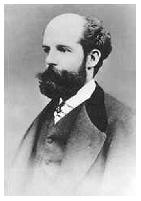Dry Cell Battery
In 1866, French engineer Georges Leclanché developed the first zinc-carbon battery, providing for low-cost and practical storage of electricity. His design was soon adopted by the telegraph industry and would be made safer and more reliable through the development of “dry” cell technology. The Leclanché cell lives on today in the ubiquitous alkaline battery.
Leclanché was born in Parmain, France, in 1939 and received an education in England and at France’s Central School of Arts and Manufactures. In 1866, he patented a wet cell battery that marked a major innovation in the field. Leclanché followed the basic principle in battery design pioneered by Alessando Volta’s voltaic pile. His battery contained two terminals—an anode (negatively charged electrode) and a cathode (positively charged electrode)—and an electrolyte, a chemical solution that could conduct electricity. But unlike the lead-acid batteries that had proliferated in the first half of the nineteenth century, Leclanché replaced sulfuric acid with a solution of ammonium chloride, and switched lead for a negative terminal of zinc, and a positive end composed of manganese dioxide.
Lighter and less toxic than the lead-acid battery, Leclanché zinc-carbon battery produced electricity when the zinc oxidized, causing the material to give up its electrons and create an ion with a positive charge. The zinc ions moved away from the anode, leaving their electrons behind on the surface. If the battery was linked to an outside circuit, those excess electrons would flow through the electrolyte to the manganese cathode and out to the external circuit. This process generated 1.5 volts of power. This battery became useful for devices requiring intermittent current, such as telegraph lines and electrical signals and bells.
The wet cell design was prone to leakage: it packed the manganese dioxide cathode inside a porous pot that was submerged with the anode in ammonium chloride. German chemist Carl Gassner installed a low-moisture paste electrolyte into the cell, creating a “dry cell” battery less likely to break or leak. The zinc-carbon battery could now be used in a broader range of applications.
Modern batteries are smaller, safer, and longer-lasting than the original Leclanché design thanks to changes in their chemical composition. Producers removed mercury from the zinc alloy to lower their toxicity, and switched the electrolyte to potassium hydroxide, which gave a longer life to batteries powering flashlights and consumer electronics. This new solution was a base, rather than an acid, leading to their new name: alkaline batteries.
